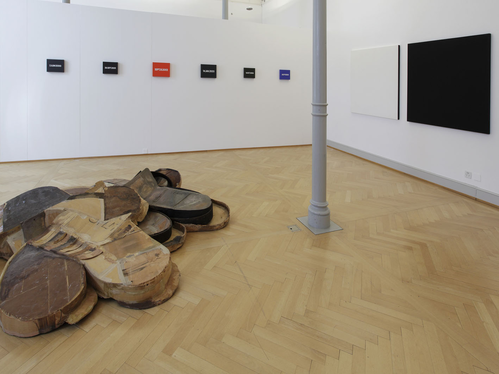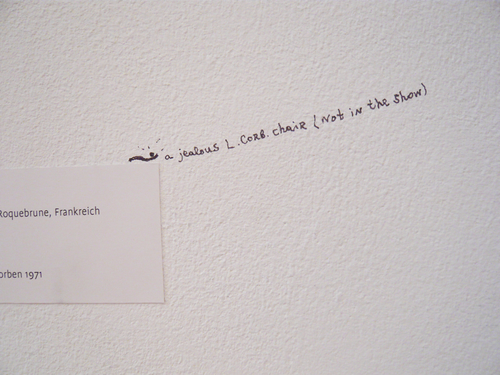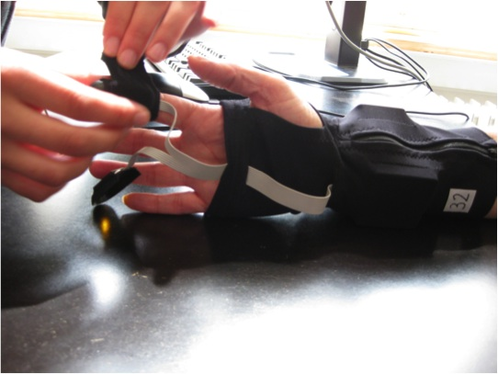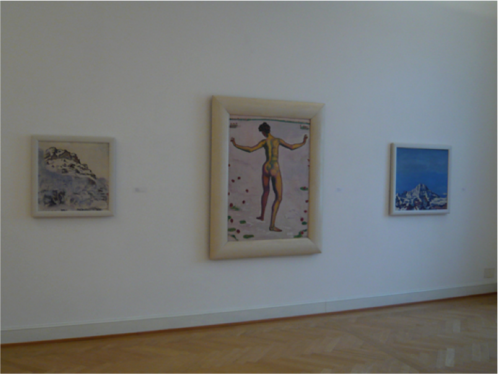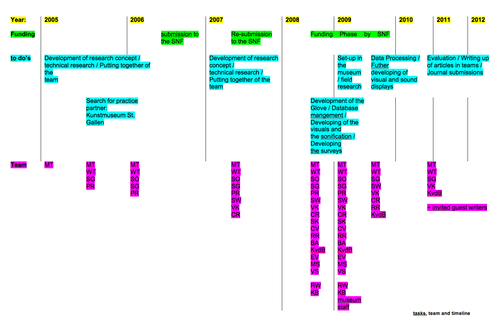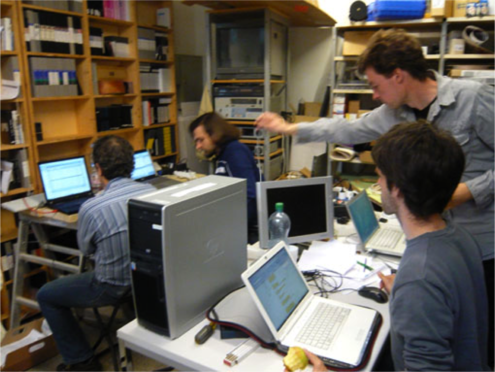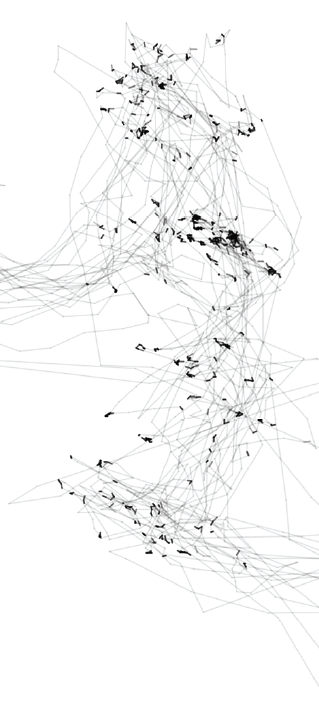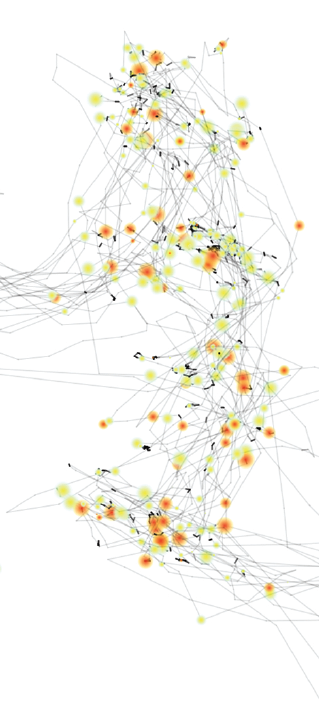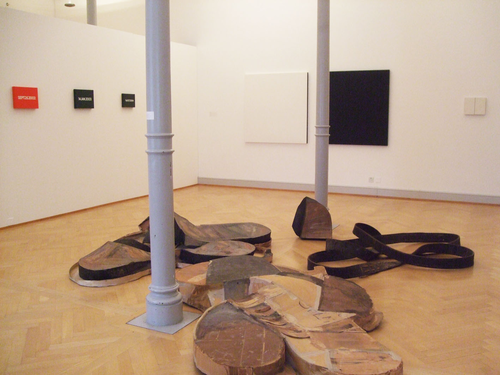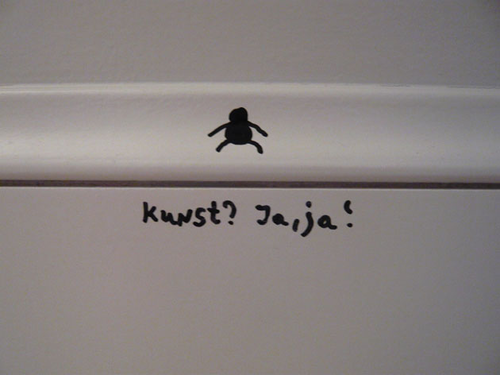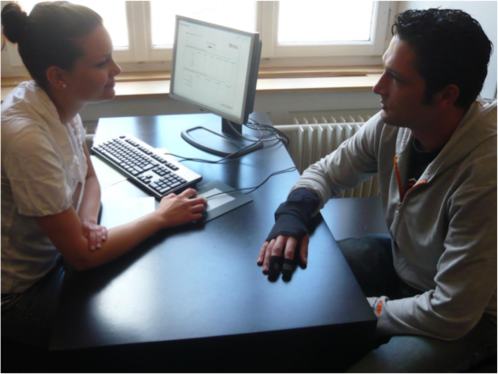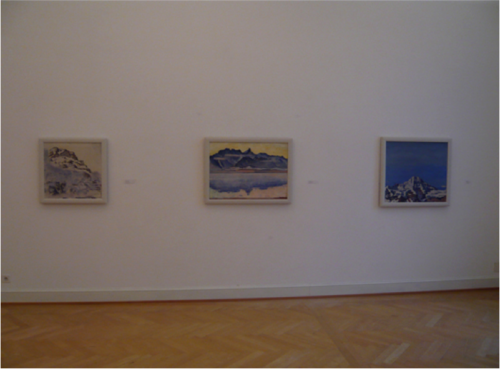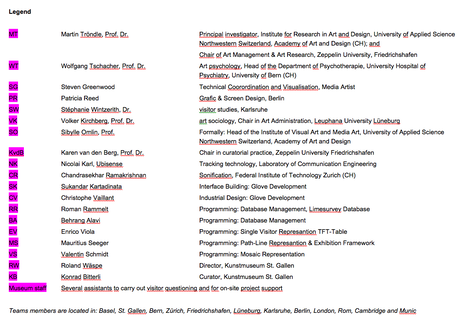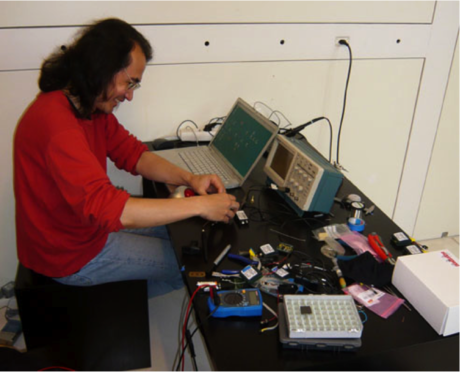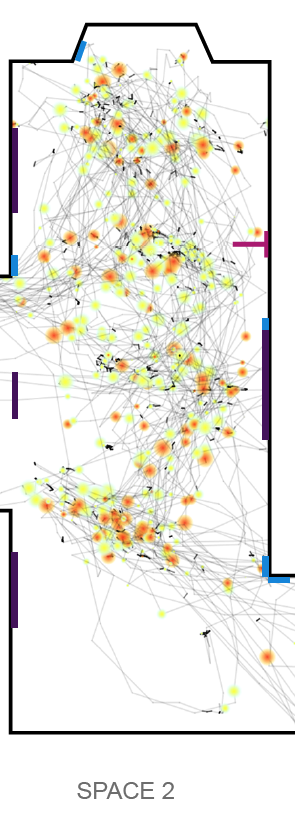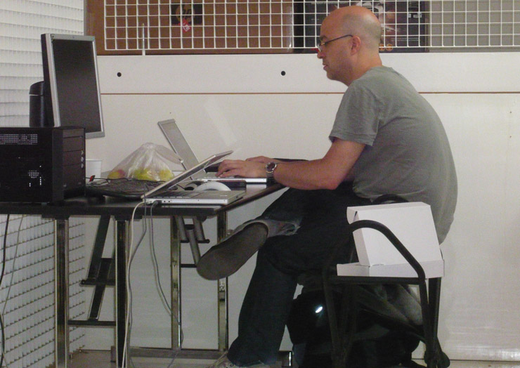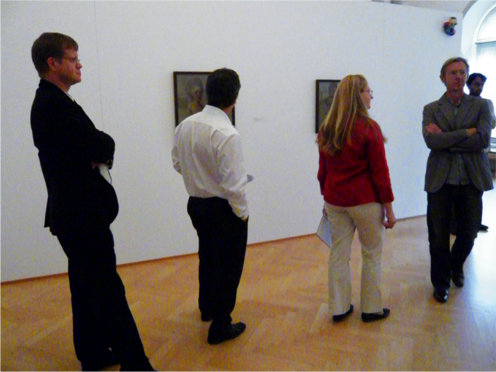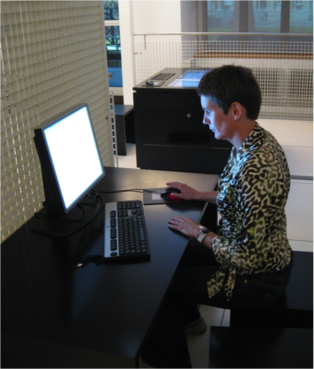The Research Project eMotion and some Results
eMotion analyses the experience of the museum-goer experimentally. The research project attempts to develop a holistic understanding of the interaction of art work, curatorship and recipient – including the relation of the art object to the observer, as well as the relation between the observer and their social context, speaking of their experience, expectation and other social and psychological variables. To gain access to this complex realm of visitor reception in the museum, we employed methods of visitor tracking, biometric measurements, empirical social science, data-sonification and the experiment itself — as an intervention and installation — developing and combining these in a complimentary fashion.
The research interests of the various team members coming from different disciplines e.g. curatorial studies, art theory, art sociology, reception psychology did lead to multiple perspectives on the question of art reception in a fine art museum. It is not possible to discuss the various results in detail but some brief examples shall be given.
In the article, ‘Physiological correlates of aesthetic perception in a museum’, we demonstrated that physiological responses, such as cardiac measures (heart rate variability, heart rate level) and skin conductance variability were significantly related to aesthetic-emotional experiencing during perception of an artwork. To our knowledge, this is the first study providing statistical support for the embodiment of aesthetics for a large, representative sample of visitors (Tschacher et al. 2011). [5]
In order to differentiate these findings, we focused our research outlined in the following sections on the effects of artworks (Tröndle/Tschacher 2011). We demonstrated that the phenomenological experiences of single works do indeed have a strong impact on the physiological response of the beholder. We showed, for the first time, how the impact of single artworks differs from beholder to beholder, and from this, developed an empirically grounded concept for integrative aesthetics, which transcends the methodological and theoretical purism of the disciplines. [6]
Rather than focusing purelyon the analysis of the effect of single artworks, a further focus of the research project was the effect of curatorial groupings and stagings. In the article, “The affective effects of curatorial contextuality: How curatorial arrangements effect art reception in a fine art museum”, we investigated how curatorial and spatial arrangements affect the visitors' attention. We conducted a series of experiments e.g. rehanging artworks and changing spatial arrangements in the museum. [7] Using the diagrams of the participating artist, we demonstrated that every curatorial setting forms complex force fields within an exhibition which affect the beholder. We also revealed that curatorial settings often vary from what is expected.
A more art sociological perspective was taken when we asked ‘Is this Art?’ Assisted by Bulgarian artist Nedko Solakov, we carried out an in-depth investigation of the decision art/non-art of fine art museum visitors, both empirically and experimentally. Contrary to the major sociological art theories (e.g. Bourdieu, Danto or Dickie), we found that neither the socioeconomic characteristics nor the art expertise or the information about an artwork have significant influence on the decision art/non-art and that the decision is driven by various, somewhat unexpected factors. [8]
Further articles and various outcomes could be mentioned. In total, more than a dozen peer review journal articles, presentations on more than twenty international congresses and several book chapters evolved out of this research project. [9] When considering the international media attention, which the project received, [10] and particularly the rich and varied research results, one might ask why and how this success has been evoked. Therefore, our aim in the following sections is to focus on the research process itself: the modes of transdisciplinary research and collaboration.
eMotion: Tasks, Team and Timeline
A brief description of the experimental setting: Visitors who were willing to participate in the research project were provided with a data glove at the entry, which was put on by the project staff. The participants, equipped with the data glove especially developed for the eMotion project, entered the exhibition. Via the sensors in the glove, the spatial behaviour of the visitor (path taken, time spent in front of an artwork, speed at which they moved through the exhibition) was accurately recorded (every second, with a precision within 15 cm). In addition, two physiological markers were measured: heart rate and skin conductance variability. The data were collected via an especially installed wireless network in the museum spaces. These data (amounting to several terabytes) were computed and saved on a central server by two programming and database specialists, using different formulae for every visitor. These raw data, in turn, provided the material for the artistic transformation, which was carried out by Steven Greenwood (Visuals) and Chandrasekhar Ramakrishnan (Sound) with support from further Programmers and Designers, as well as an Interface Developer. These data collections were methodologically supplemented by electronically based questionnaires which were completed before and directly after, as well as four weeks after the tour of the exhibition (entrance, exit, delayed survey).
The video on the right (Fig. 4) gives the viewer an impression of the museum space, the research setting and the exhibition.
In addition, experimental rehangings of individual artworks were carried out, in order to test different hypotheses, about the effect of hanging orders, curatorial groupings or the effect of information on art reception (see Fig. 5).
The duration of the project, including its preliminary phase and the not-yet complete evaluation phase, is approximately five years. The data collection phase took place at the fine arts museum St. Gallen. This phase of the project began in June 2009 and was completed in August of the same year. [11]
A rough outline of the project and associated tasks is shown in Fig. 6: Task, team and timeline.
Artistic Research Practice und Displays
The genuinely artistic part of this project can be immediately identified in the development of different visualisations and tonal translations. Not only were these presented in an interactive installation at the end of the exhibition, but they were also used to develop the imaging processes. The latter acted as a basis for an image-analytical-interpretative evaluation. The primary aim of the participating artists was therefore not to produce artworks. Instead, it was to make artistic methods of visualisation and sonification useable for museum research, which would, in turn, make exhibiting and showing conditions better researchable. The artistic transformation of the research results by Steven Greenwood and Chandrasekhar Ramakrishnan rendered the effect of the respective arrangements audible and visible in sound sequences and monitor images, and also delivered a condensed analysis of fleeting art reception moments.
In addition to this more service-providing role, media artist Steven Greenwood contributed the physiological tracking and mapping as a pioneering research practice to the project. From the beginning, its intended use was to record the position of the visitors, but not, in the project's early stages, to obtain physiological data and to then couple this data with visitor location. It was also the artists who considered a diverse range of forms of data portrayal. The idea which lends the project its specificity, that is, the idea to make the gathering of physiological data visible and audible, is owed to the participating artists. Similar procedures had, up to this point, never been realised. Almost incidentally, as a result of the wish to experiment, a new examination method for the investigation of spatial behaviour was created.
Image Production and Authorship
The visual elements included the possibility for the exhibition visitors that participated in the research project to play a video of their tour through the exhibition and to obtain a printed version of the diagram, in total 352 individual diagrams were created. These diagrams resemble Figures 7a and 7b, which represent a section of the exhibition tour taken by visitor number six. The visitor’s path through the exhibition spaces is represented by a black line. The faster the participants moved, the less dense the lines. Heart rate significance is represented by a yellow marker and skin conductance by an orange marker, the larger the markers, the stronger the reactions. The ‘effect regions’ of the artworks are filled in, in green. Artworks that were part of a group of works are joined by dotted lines.
One can ask the question: To what extent eMotion diagrams, produced via the mapping process, also resemble drawings? If one reads the lines essentially as gestures and as the trail of an acting individual, the eMotion diagrams could be compared to the radically reduced drawings by Norbert Kricke. However, in the case of the mapping technology, the production process has a conceptually different meaning. The development of the data glove, the tracking technology, the data base architecture and the collaboration with the scientists and programmers, portray to a greater degree the background of diagram genesis than they do the work strategies belonging to the art field and the associated construction of authorship (see Caduff 2007). To consider the printed out diagrams as compositional objects and then to assess them from aesthetic points of view would therefore be nonsensical. Nevertheless, aesthetic points of view do play a role in the visual realization of image-producing processes such as these, where colour choice is concerned, line thickness, and similar decisions. Here, however, creative decisions are determined according to other criteria — according to questions of clarity and evaluation.
Over the course of the research project, the development of the mappings as well as of the sonification was a collective process that was equally oriented towards aesthetic, scientific and technical qualities, as well as the individual capabilities of the participating artists, graphic designers, programmers and scientists. First drafts were drawn up and discussed with the project leader from scientific and aesthetic perspectives, which were then either rejected or further developed. Prototypes of portrayal methods were subsequently tested with the programmers for their technical feasibility and shown to additional programmers who functioned as visualisation specialists. It goes without saying that the cost and time budgets influenced the development of individual displays. In addition, the materiality and aesthetic of still and moving images as well as of the sonification are also determined by the programming languages employed, which as a result influenced the scientific evaluation process. In this respect, it emerged as characteristic of the eMotion project, that ideas regarding authorship in this framework became largely fluid and flowed into a collective. Thus, one cannot talk about the emphatic authorship, which is characteristic of the art field (Groys 2001). What appears more fitting is a description of the procedure as a negotiation process, which is curated by the project leader.
At the same time, this holds a certain danger for the participating artists. When the balance between commissioning and self-commissioning is delicately shifted and the artistic margins, which are necessary in order to independently deal with the material, are continuously restricted by other researchers and their compatibility demands, the understanding of artistic autonomy, which still prevails today despite all postulates (Barthes 1968/2000), is contradicted. In other words, Greenwood had to deal with the fact that his diagrams were more a basis for scientific evaluations than they were artistic artefacts, adhering nevertheless to his aesthetic demands in terms of the diagram creation and putting the installation into place which, within the framework of the exhibition, had to prove suitable to the museum. Enduring this ambivalence can be a challenge for artists in research contexts.
The Raw Data Myth
Image-producing procedures as well as complex statistical evaluations supposedly precisely reflect reality. However, this empirical evidence is, to a large extent, constructed. As noted, the development of the tracking and physiology instruments for the appropriating of data in the field is not simply done, instead, the processing of these raw data to yield useable data from which information can be generated, is part of a scientific and aesthetic construction process. Following the field research phase, almost one year was spent developing the formulae alone, testing them and discussing them, and either rejecting or altering them. The formulae developed from the immense amount of data were deemed to be representative of relevant information for the team according to premises previously negotiated among the researchers.
The process of further developing the sound and image-producing procedures was similar: Greenwood and Ramakrishnan, on their own initiative or following stimulation by the project leader, experimented with computational formulae, tone qualities, density, thicknesses, with different numbers of people that should be mapped etc., in order to render the data interpretable as graphics and sounds, (see Fig. 8).
Within scientific research and image science, it is repeatedly stressed that images do not only depict reality in an objectifying manner, but also, for their part, encode (see e.g. Heintz/Huber 2001; Rheinberger 2010). As models, visualisations, graphs or indices, they do not only render visible, they introduce new codes, whose realism and meaningfulness should in turn be critically considered. The handling of scientific images is acknowledged to be an interpretative practice on a different level (see e.g. Ratsch/Stamatescu/Stoellger 2009).
Use of Images
The goal of cartographies of measured data is to evaluate the data using pattern recognition. The analysis is carried out and compared to a sample representing a ‘normal situation’, constructed for the experiment. The pattern recognition assumes that deviations or unusual features can then be interpreted. Cartographies were analysed according to this point of view during the evaluation phase of eMotion. On the one hand mappings were examined for similarities to and deviations from the pattern, and on the other hand, mappings were created in view of the hypotheses, and these then analysed.
What categorically distinguishes the scientific handling of images from artistic image practice is above two aspects: firstly, the margins of interpretation and secondly, the completely different division of labour, in handling the images. While artistic images enable the most ambiguous interpretations possible, scientific images aim for unambiguousness. They are produced in order to represent something concrete. They are ‘instruments’ and ‘images to be used’ (Boehm 2001:49). Materialisation practices, image-producing procedures und any modes of formation are, in art, not only a means to an end, but constantly reflect their own point of view in the artistic practice. And this is one of their goals. Art images have been, since the beginning of modern times, images about images, that is, images that thematise their status as an image. This is similar and analogous in the reception-aesthetic practice which is a constant perception of perception itself (see Seel 1997). In hindsight, it was exactly this knowledge of perception-based reflection — and in the long run, to a lesser extent, the artistic heuristics of the ‘As-if mode’ — that was made use of by the eMotion team for the development of a new form of art perception visibility in the museum. In art research projects, the two image practices can be combined, thereby enabling research benefits.
Materiality
In the production of knowledge in artistic mode, not only does materiality predetermine significant framework conditions within which the production of meaning can then take place, but the materialisation can also be — as was the case for the creation of the media installation for eMotion — a point of departure and a goal at the same time. In the process, the choice of material influences the structure formation. The material choice facilitates certain things and impedes others, thereby determining from the outset what is possible and what is not, and similarly, what will become visible and what will not (for more detail see Tröndle 2011). For this reason, in eMotion, we commissioned two different artistic representations of the data material — image and sound. Not until the experimental process of reading the data began did it become clear where the epistemological additional value lay, both distinguished from one another and also distinguished from conventional scientific methods. Can something be experienced in sound which is different to what can be experienced in an image? Does something appear in movement which is different to what appears with a statistical procedure? What appears different in the aesthetic materialised results, as opposed to via, for example, a mathematical-statistical, a quantitative social scientific or a phenomenological method?
To begin with, the scientists involved in this project (sociologists, psychologists, visitor researchers, art theoreticians) were thoroughly critical of these artistic research partners and, for several years, it was not clear to them what epistemological additional value the artists could bring to the project. Not until one year after the completion of the field research phase did this fundamentally change. It was via the artistic representations that phenomena of the research subject became and continue to become visible, which would not have been possible using social science, statistical-mathematical, phenomenological or critical research practices. The artistic displays became equivalent, valid instruments, which provided sustainable stimuli to the discourses in art sociology, art theory and curatorial studies.
Even two years after the experiment was carried out in the art museum, we are still occupied with the difference between the two artistic data transformations carried out as part of the evaluation process, especially the sonification.
The visitors' data is represented on the visual level, as well as on the acoustic level. The acoustic procedure creates data representations that can be interpreted using a different sense. The acoustically transported information includes data that cannot be transported via visual representations alone, such as the visitors' mood and in particular the varying phases during their visit. The valeur ajoutée, or ‘surplus value’, is obtained via the communication of data using different codes, to be interpreted by different senses or via different channels of perception. The additional acoustic representation is thus in no way rendered redundant.
The audio installation belonging to Chandrasekhar Ramakrishnan is entitled, Positus Musarum or The Muses' Poses, and it performs the transformation of the data collected into sound. Particular moments in the interaction between an artwork and an observer are represented via the installation's use of the logic of sound, which differs from the logic of an image. The sensual knowledge represented by the sound affords an additional form of the data. Musical parameters such as volume, duration and pitch vary with variations in the data. Two voices are assigned to each visitor, one which varies with the visitor's position in space (see Fig. 10), and the other which varies with skin conductivity and heart rate.
A high-pitched voice represents each work and this sound continues for the duration for which the visitor observes it. An increase in physical engagement by the visitor is accompanied by a noticeable rise in voice volume. Interferences and friction signify the moment in which the work interferes with the observer. [12] Here again the data of visitor number six is used in the sound display.
The diagrams and videos conceptualized by Steven Greenwood could be relatively well used for the evaluation by the scientists after a few months. Although the sound sequences provide a new perspective on the museum experience via their temporality, we have not yet found access to this form of transformation. Despite the fact that their generation and controlling parameters are known, these sounds remain almost an enigma.
Research Management
Just as artists have had to adjust to new forms of image usage, for those researchers who were not used to dealing with images, more robust meaning patterns evolved initially via the many image comparisons and the constant testing of particular phenomena, and lastly, via cross-checking with other data, such as the surveys. Here the aim was again, as always, to admit to a certain experimental dilettantism within the evaluation process. One prerequisite for the achievement of this, and the work beyond the usual disciplinarily drawn-up fields was the establishment of a research management. It very quickly became clear, that research management was particularly important for such a time-consuming project, not only because results and time plans are not as predictable, but also because it was necessary to continually re-communitise methodical and theoretical competences. Furthermore, the sociality of a research group carrying out such a long process must be first and foremost constituted, and the authorship of the research is determined differently to the way the artists, humanities experts and social scientists were overall used to.
In addition, a team division became clear, that was difficult to overcome right up until the point of evaluation. On one side were the artists and programmers; on the other were the humanities experts and social scientists. To mediate between the latter individuals, to produce the necessary understanding of research questions and hypothesis forming and to reconcile this with the technical developments over several years, was and is the central challenge of the project. In the discourse of the newer science-studies the connection between institutionalized social practices and knowledge genesis has been sharpened in the last few years (Knorr-Cetina e.g. 1988; Latour 2001 and 2001a). Research is thus not only described as action affected by socio-cultural factors, but also as a socio-cultural practice by itself. These practices of knowledge genesis will be described in this following section.
Dilthey's Difference
The difference between the natural sciences and the humanities, against the background of the five-year-long eMotion project carried out by an interdisciplinary research team, appears to be culturally conditional — that is, it appears to be a question of the university-disciplinary socialisation as well as a question of faith in scientific theory. With the increasing differentiation of scientific disciplines and the constant increase in available knowledge, scientific culturalisation processes no longer only take place between the natural sciences and the humanities, instead, they also take place between the individual fields (see Balsiger 2005:51f.). [13]
In line with the anthropological notion of culture, ‘culture’ should here stand for historically developed value and thought patterns. [14] This notion of culture, anthropologically shaped, has been adopted particularly by the sociologically based Organisation theory. Universities, Institutes, departments and disciplines can all be considered as organisations, and therefore it is worthwhile to carry out a perspectivation of our questions from this angle. The starting point of these considerations is that social systems unconsciously establish rules and a rule-producing mechanism via interactions of its members. This mechanism influences the members' construction of reality. Organisational cultures are created accordingly, via the orientation of community members towards one another and towards the situation (Schreyögg 1992:1526). The respective organisational culture shapes ‘[...] a shared system of references, a lens, that filters perceptions and influences expectations, that enables shared interpretations and reduces complexity, and that guides and legitimises actions’ (Kieser 1984:4). This organisation theoretical functional description of the phenomenon of culture is meaningful for our scientific theoretical consideration, due to the fact that fields and disciplines are first and foremost neither object boundaries but historically developed communication systems (Luhmann 1994:446). In order to be part of the art sociologists' community, for example, a connection (Anschlussfähigkeit) must be made to the current themes in art sociology. That is, one has to occupy him or herself with whatever is treated as important within art sociological discourse at that particular time. One has to work with methods that the community is familiar with, that is, one must follow the rules that exist within the field. It is also imperative that one speaks the language of the art sociologists, or even better, a dialect spoken by sociologists which indicates that one is ‘from the region’. This culturalisation of scientific disciplines results in narrations: individuals communicate with one another at symposia and conferences, as well as in relevant journal publications, as to what the problem might be and what methods could be used to solve it. One uses citations which are indicative of one's own thought horizons, thereby sending membership signals to the community. Journals, for their part, make it clear what connections one should make in order to become compatible, whether it be using particular terms, styles, or methods. Journals fulfil this role because they themselves are shaped by themes and methods. And even without drawing on elevated discourse and questions of power, it becomes clear to which knowledge limits such disciplinary and field-specific practices lead (see Mittelstraß 2003:7).
What we have learnt in the past few years is: If new insights are to be produced, then a new research organisation must be found — that is, new methods, processes and a social research setting which overrules the disciplinary bias of its participants. One's own bias first becomes visible when other team members wonder at one's work, or when the empirical material brings to light something other than what one had considered to be a given, as a result of disciplinary influence upon one. These situations arise time and time again in our research project and ultimately, they evoke small sensations: they create new knowledge of an object that one had assumed he knew everything about. ‘Discipline purism and separatism are obsolete strategies’, according to Wolfgang Welsch (1996:107) and he advocates a ‘transition from separatist thinking to integrative thinking’. Making this step enables a qualitatively new research practice and thereby promotes new knowledge. This is due to the fact that the gap between the natural sciences and the humanities is ultimately to be observed in the different methodical competences in correlating and interpretation, which can be far better combined than eliminated one-sidedly.
Transdisciplinarity
Transdisciplinary research requires the ability to connect to research networks involving scientists, artists and practitioners. Jürgen Mittelstraß understands transdisciplinarity as a principle of research and science, that ‘has an effect anywhere, where a definition of problem areas and problem solutions from one field or discipline alone is not possible, or where it goes beyond definitions of this nature’ (Mittelstraß 2003:9). Transdisciplinarity is therefore not a theory. Instead, it is a principle that leads and directs research, which accompanies a particular organisation form, which distinguishes itself via a high level of integration. [15]
The object of research in transdisciplinary research projects possesses its own existence, which would never be the case in laboratory science: ‘while research often aims to disable random factors in order to attain clear models and resilient causal explanations, transdisciplinary research is reliant on the accepting and the incorporation of concrete circumstances and, as the case may be, the critical modification of these circumstances’ (Krohn 2008:62f.). This requires a particular quality of research design and of development of specific research methods, whose development, in our experience, particularly in collaboration with artists, can be successful due to the fact that they are disciplinarily unencumbered. Generally, in a transdisciplinary project, several methods are introduced in combination (e.g. tracking, physiology, inquiries, experiment). Methodical approaches can also be developed from scratch or can be modified — as in the case of eMotion — if these modifications are adequate according to the object of research and are beneficial for the participant integration of sub-disciplines. Method development using transdisciplinary teams can, in this way, contribute to methodical progress (cf. Pohl/Hirsch Hadorn 2008:87).
(Un)disciplining the Disciplines
To be able to observe the world from a particular disciplinarily shaped perspective and to be able to offer these observations to society in terms of differentiation output, one must consider the culturalisation of the disciplines. Scientific observational output is coupled with the disciplining of the disciplines. However, one is forced to experience the problem of loss of scientific connectability. The art of research is therefore to play a delicate game, achieving a balance between openness and closedness: Closedness, in order to enable discipline-specific perspectives, and openness, in order to be able to exercise sufficient irritations, which will result in new differences in observation and description in the research process alongside already familiar ones. This is, however, not achievable via a single-scientific or single-disciplinary procedure. Rather, a new organisation form of research is necessary, which has operated for the last few years under the term of transdisciplinarity (see Mittelstraß 2003; Balsiger 2005; Bergmann/Schramm 2008; Hirsch Hadorn et al. 2008).
The cooperation beyond one's own theoretical and methodical disciplinary boundaries evokes uncertainty among scientists, due to the fact that one has to move into unknown territory, as soon as one leaves the cosmos of one's theoretical, methodical discipline. This uncertainty can only be productive when conceived as a chance to question one's own habitus and mode of knowledge production (see Pohl/Hirsch Hadorn 2008:75). The coordination of professional expertise and the integration of the cores of knowledge accepted within the discipline is the central epistemological quality of transdisciplinary research (Krohn 2008:64). In order to accept this, to create openness within the team and to use the differences productively, there needs to be a scientific curator, who attempts to overcome the scientific and artistic ‘doing it alone’ approaches, and to set a habitual osmosis in motion (see Tröndle et al. 2009).
As a result of the eMotion research process, we learnt that in order to fulfil the transdisciplinary demand of the research project, every article of the team should be realised by at least two people, in most cases three or more, from different disciplinary backgrounds. The idea is to evoke a methodical and theoretical perspectivation of the object of study, which then precipitates in a multiple scientific authorship. Not until the writing of articles for eMotion was it observed, that the diverse theoretical locations, the different methodical competences, the characteristic language style, the publication logic and the disciplinary socialisation of the authors at times build barely surmountable hurdles in collaboration. The evaluation process was enriched, as intended, by the multi-perspectivation, however at the same time, it was slowed to a great extent and also rendered more difficult. Particularly scientists coming from art theory and social science, who are not used to working in teams, find it difficult to share authorship and to accept different procedures as the familiar ones. We might come to this very conclusion, having arrived at the end of our five-year-long collaboration: the choice of methods, theories and research organisations is not only a question of the objects or process under investigation — this being the idealistic assumption — rather, it is more a question of personal abilities and affections.
The way to integration therefore begins with a jointly shared research interest (here: How does art reception function in a museum?), jointly developed hypotheses, a jointly developed method setting that covers a large range of purely quantitative and qualitative forms, as well as the joint creation of products, ranging from technical apparatuses, to an exhibition, and eventually to a data collection (see Thompson Klein 2008:97). This then leads to the joint evaluation of collected data, the joint compilation of the publication and a social moderation for the establishment of a joint ‘project culture’. All this requires much greater time expenditure than an intra-disciplinary procedure or work carried out alone.
Theory compatibility
Considering research as ‘the creation of theories with scopes that continue to become larger’ (Seiffert/Radnitzky 1992), causes one to very quickly reach the limits of the research setting. In transdisciplinary research settings, it is not the scope of the theory which is so crucial (which in most cases claims the dominance of a particular field), instead it is the compatibility of the theory to others who also seek to make sense of the same phenomenon. Only in this way can different descriptions be integrated, and with them complementary perspectives. Instead of a dominant knowledge practice shaped by a single theory, a practice which is exclusive and truth-claiming, this project searches for a knowledge practice that integrates method plurality and aims for theory compatibility with respect to utility, in order to take into account the ambiguity of complex objects of study. [16] The artistic mode of the research process can contribute to this, due to the fact that it can cope with ambiguity much more effectively than scientific disciplines. Because, in contrast to science, which aims for unambiguousness in the course of knowledge production, art operates via openness to interpretation by activating our sense of what is possible. This was made clear by the eMotion project and also changed our team's very research process.
Art research
The transdisciplinary thought in terms of new organisational forms for the creation of knowledge can be further developed. The central theme, under the heading of ‘art research’, is to learn from the epistemological techniques of the arts. Dieter Wuttke states that the separation of natural sciences and humanities into ‘two cultures’ has become obsolete. In order to reach one overall science, he considers that a ‘change in scientific mentality’ is necessary (Wuttke 2003:7), that discards its awareness of the separation and is ‘hybrid to the arts whose method is sensual research, with results that can only be obtained in this manner [...]’ (ibid. 2003:80). Such a transdisciplinary entanglement of art and science distinguishes the research setting of the eMotion project. Transdisciplinary research, such as that practised here, conceives the arts and the sciences as different, but equal, forms of knowledge production and renders art research methods for knowledge processes fruitful. [17] Art research transdisciplinarily combines artistic research practice with scientific research methods and thereby changes the social practice of research itself. [18] This reciprocal irritation, as well as the gain in differentiation output from which both sides benefited, contributed and continue to contribute to the success of this project, would never have been achieved by the singular science alone, or without artist participation.
Hurdles
Why, however, are there so many difficulties associated with transdisciplinary research projects, even with the participation of artists in the scientific field, when the epistemological benefits are convincing? Firstly, the majority of research at universities has disciplinary aims: there are few experiences of transdisciplinary research projects (Bergmann/Schramm 2008:7) and the understanding of collaboration with artists rarely goes beyond the idea of making scientific diagrams ‘prettier’. Often, science has been lacking in its understanding of art, and its capacity to imagine what options can be made available via such a procedure.
Secondly, the time costs for interdisciplinary collaboration are very high, as are the communication and moderation costs. In addition, the acquisition of external funding for transdisciplinary research projects is difficult to achieve. Research requests are mostly assessed with the discipline-based expertise of the reviewer, ‘[...] such as, on the one hand, the requests don't reach the disciplinary standards and on the other hand, they are not seized due to their specificity’ (Bergmann/Schramm 2008:8). In addition, publications of research results that have been transdisciplinarily compiled are difficult to have accepted in a publication setting characterised by disciplinarity. [19] Transdisciplinary research projects are also risky — due to the fact that the process is highly unpredictable and that they thus can fail.
And thirdly, artists have a tendency to refuse the process of the division of labour, because they fear losing their status of artist in the art world, even though this opportunity would give them access to a socially relevant field of action which lies beyond the distinction game of the art market.
In summary: the way to a transdisciplinary research culture in science is long but worthwhile for scientists and artists, should they indeed be interested in solving real problems and acquiring new knowledge. However, the following comment must be made in order to put this article into perspective: transdisciplinary research is not necessarily better than other research formations. It is one possibility to create new knowledge about something, and we experienced it to be a very effective one.
If one were to choose to work collaboratively in a diverse research team of (social) scientists, artists, technicians and practitioners, one might come to the following conclusions after reflecting on his experiences: the role of the principal investigator, that is, of the scientific curator, must be established. The mediation of mind-sets, theories, methods and personalities must be of high importance in the definition of such a role. A steady focus must be maintained on the composed network of actants and the dynamics it creates on the construction of knowledge. To be able to mediate this research process, one must be aware of the relevant literature on the research topic and the methods and theories of the scientific and artistic disciplines involved, as well as be able to manage time and budget. However, one must also possess the ability to mediate between different research cultures, as well the ability to compose an effective research network. This should be a crucial point in university departments which educate actors in the field of artistic research.
References
Philip W. Balsiger, Transdisziplinarität. Systematisch vergleichende Untersuchung disziplinenübergreifender Wissenschaftspraxis (München: Fink, 2005).
Ingrid Balzer and Monika Wächter, ‘Qualitätsaspekte der Administration und Begleitung transdisziplinärer Forschungvorhaben’, in Transdiziplinäre Forschung. Integrative Forschungsprozesse verstehen und bewerten, ed. by Matthias Bergmann and Engelbert Schramm, (Frankfurt am Main: Campus Verlag GmbH, 2008) pp. 275-292.
Roland Barthes, ‘Der Tod des Autors’, in Texte zur Theorie der Autorschaft, ed. by Fotis Jannidis, Gerhard Lauer, Matias Martinez and Simone Winko, (Stuttgart: Reclam 1968/2000) pp.185-193.
Transdiziplinäre Forschung. Integrative Forschungsprozesse verstehen und bewerten, ed. by Matthias Bergmann and Engelbert Schramm, (Frankfurt am Main: Campus Verlag GmbH, 2008).
Elke Bippus, Kunst des Forschens, (Zürich: Diaphanes, 2009).
Gottfried Boehm, ‘Zwischen Auge und Hand’, in Mit dem Auge denken. Strategien der Sichtbarmachung in wissenschaftlichen und virtuellen Welten, ed. by Bettina Heintz and Jörg Huber, (Zurich, Vienna and New York: Springer, 2001) pp. 43-54.
Henk Borgdorff, ‘Künstlerische Forschung und akademische Forschung’, in Kunstforschung als ästhetische Wissenschaft. Beiträge zur transdisziplinären Hybridisierung von Wissenschaft und Kunst, ed. by Martin Tröndle and Julia Wärmers, (Bielefeld: transcript, 2011) pp. 69-90.
Komparatistische Beiträge zur Forschung in Design und Kunst, ed. by Vera Bühlmann and Martin Wiedmer, (Zurich: Ringier, 2009).
Corina Caduff, Autorschaft in den Künsten. Konzepte - Praktiken – Medien, (Zurich: Zurich University of the Arts, 2007).
Art and Artistic Research. ed. by Corinna Caduff, Fiona Siegenthaler and Tan Wälchli, (Zürich: Scheidegger & Spiess, 2010).
Boris Groys,‘Die Politik der Autorenschaft’, in Lesebuch, ed. by Angelika Stepken, (Karlsruhe: Badischer Kunstverein, 2001) pp. 12-17.
Art and Innovation. The Xerox PARC Artist in Residency Program, ed. by Craig Harris, (Cambridge, London and MIT Press, 1999).
Mit dem Auge denken. Strategien der Sichtbarmachung in wissenschaftlichen und virtuellen Welten, ed. by Bettina Heintz and Jörg Huber, (Zürich, Vienna and New York: Springer, 2001).
Handbook of Transdisciplinarity, ed. by Gertrude Hirsch Hadorn, et al., (Heidelberg: Springer, 2008).
Alfred Kieser, Organisation, (Berlin: De Gruyter, 1984).
Karin Knorr-Cetina, Die Fabrikation von Erkenntnis. Zur Anthropologie der Naturwissenschaft, 2nd Edition, (Frankfurt am Main: Suhrkamp, 2002).
Karin Knorr-Cetina, ‘Das naturwissenschaftliche Labor als Ort der ‚Verdichtung‘ von Gesellschaft’, in Zeitschrift für Soziologie, (17 Jg, Issue 2, April 1988) pp. 85-101.
Wolfgang Krohn, ‘Epistemische Qualitäten transdisziplinärer Forschung’, in Transdiziplinäre Forschung. Integrative Forschungsprozesse verstehen und bewerten, ed. by Matthias Bergmann and Engelbert Schramm, (Frankfurt am Main: Campus Verlag GmbH 2008) pp. 39-67.
Bruno Latour, ‘Eine Soziologie ohne Objekt? Anmerkungen zur Intersubjektivität’, in Berliner Journal für Soziologie, (Berlin, 2001) pp. 237-252.
Bruno Latour, ‘Gabriel Tarde und das Ende des Sozialen’, in Soziale Welt, (No. 52, 2001a) pp. 361-376.
Bruno Latour, ‘Die Versprechen des Konstruktivismus’, in Interventionen 12: Person/Schauplatz, ed by Jörg Huber, (ith Zurich and Vienna: Springer, 2003) pp. 183-208.
Bruno Latour and Steve Woolgar, Laboratory Life: the Social Construction of Scientific Facts, (Los Angeles: Sage Publications, 1979).
Niklas Luhmann, Die Wissenschaft der Gesellschaft, (Frankfurt/Main: Suhrkamp, 1994).
Claudia Mareis, ‘Methodische Imagination’, in Kunstforschung als ästhetische Wissenschaft. Beiträge zur transdisziplinären Hybridisierung von Wissenschaft und Kunst, ed. by Martin Tröndle and Julia Wärmers, (Bielefeld, transcript, 2011) pp. 203-243.
Design Research Now, ed. by Ralf Michel, (Basel: Birkhäuser, 2007).
Jürgen Mittelstraß, Transdisziplinarität – wissenschaftliche Zukunft und institutionelle Wirklichkeit, (Constance: UVK Universitätsverlag Konstanz GmbH, 2003).
Hans-Ulrich Obrist and Miyake Akiko, Bridge the Gap? (Cologne: Center for Contemporary Art Kitakyushu and Verlag der Buchhandlung Walther König, 2002).
Hans-Ulrich Obrist and Barbara Vanderlinden, Laboratorium, (Cologne: DuMont, 2001).
Christian Pohl and Gertrude Hirsch Hadorn, ‘Methodenentwicklung in der transdisziplinären Forschung’, in Transdiziplinäre Forschung. Integrative Forschungsprozesse verstehen und bewerten, ed. by Matthias Bergmann and Engelbert Schramm, (Frankfurt am Main: Campus Verlag GmbH, 2008) pp. 69-91.
Chandrasekhar Ramakrishnan and Steven Greenwood, ‘Entropy Sonification’. in Computer Music Modeling and Retrieval, ed. by ICAD, (Springer: Heidelberg, 2009).
Kompetenzen der Bilder. Funktionen und Grenzen des Bildes in den Wissenschaften. ed. by Ulrich Ratsch, Ion-Olimpiu Stamatescu and Philipp Stoellger (Tübingen: Mohr Siebeck, 2009).
Künstlerische Forschung. Positionen und Perspektiven, ed. by Anton Rey and Stefan Schöbi, (subTexte 03, Zurich: ZHdK, 2009).
Hans-Jörg Rheinberger, ‘Papierpraktiken im Labor, Interview’, in Notieren, Skizzieren. Schreiben und Zeichnen als Verfahren des Entwurfs, ed. by Karen Krauthausen and Omar W. Nasim, (issue 3 of the series Wissen im Entwurf, ed. by Christoph Hoffmann and Barbara Wittmann, (Zurich: Diaphanes, 2010) pp.139-158.
HannesRickli, ‘Kunst und Forschen. Arbeit am Partikularen’, in Kunstforschung als ästhetische Wissenschaft. Beiträge zur transdisziplinären Hybridisierung von Wissenschaft und Kunst, ed. by Martin Tröndle and Julia Wärmers, (Bielefeld: transcript, 2011) pp. 91-106.
Mats Rosengren, ‘Kunst + Forschung ≠ künstlerische Forschung’, in Art and Artistic Research. ed. by Corinna Caduff, Fiona Siegenthaler and Tan Wälchli, (Zürich: Scheidegger & Spiess, 2010) pp. 118-127.
Georg Schreyögg, ‘Schlagwort „Organisationskultur“’, in Handwörterbuch der Organisation, ed. by Erich Frese, (3rd edition, Stuttgart: Schäfer, 1992).
Martin Esel, ‘Ästhetik und Aisthetik. Über einige Besonderheiten ästhetischer Wahrnehmung’, in Bild und Reflexion, ed. by Birgit Recki and Lambert Wirsing, (Munich: Wilhelm Fink,1997) pp. 17-38.
Helmut Seiffert and Gerhard Radnitzky, ‘Schlagwort „Theorie“’. in Handlexikon der Wissenschaftstheorie, (Munich: DTV, 1992).
Julie Thompson Klein, ‘Integration in der inter- und transdisziplinären Forschung’, in Transdiziplinäre Forschung. Integrative Forschungsprozesse verstehen und bewerten, ed. by Matthias Bergmann and Engelbert Schramm, (Frankfurt am Main: Campus Verlag GmbH, 2008) pp. 93-116.
MartinTröndle, et al. ‘Postkulturmanagement. Transdisziplinäre Forschung im Kulturmanagement am Beispiel des Forschungsprojektes eMotion’ in Jahrbuch Kulturmanagement 2009, ed. by Beckmesser-Feuerhahn et. al., (Bielefeld: transcript, 2009) pp. 127-155.
Martin Tröndle, ‘Methods of Artistic Research’, in Kunstforschung als ästhetische Wissenschaft. Beiträge zur transdisziplinären Hybridisierung von Wissenschaft und Kunst, ed. by Martin Tröndle and Julia Wärmers, (Bielefeld: transcript, 2011) pp. 169-202.
Kunstforschung als ästhetische Wissenschaft. Beiträge zur transdisziplinären Hybridisierung von Wissenschaft und Kunst, ed. by Martin Tröndle and Julia Wärmers (Bielefeld: transcript, 2011).
Wolfgang Tschacher, Jeannette Bischkopf and Martin Tröndle, ‘Zwei Kulturen des Wissenschaftssystems? Betrachtungen aus dem Kunstprojekt eMotion’. in Selbstorganisation von Wissenschaft. ed. by Ewald Johannes Brunner, Karsten Kenklies and Wolfgang Tschacher (forthcoming)
Karen van den Berg, Sibylle Omlin, Martin Tröndle, ‘Das Kuratieren von Kunst und Forschung zur Kunstforschung. Überlegungen im Anschluss an das Projekt eMotion – mapping musuem experience.’, in Kunstforschung als ästhetische Wissenschaft. Beiträge zur transdisziplinären Hybridisierung von Wissenschaft und Kunst, ed. by Martin Tröndle and Julia Warmers, (Bielefeld: transcript, 2011) pp. 21-48.
Wolfgang Welsch, ‘Ästhetik außerhalb der Ästhetik - Für eine neue Disziplin’, in Grenzgänge der Ästhetik, ed. by Wolfgang Welsch, (Stuttgart: Reclam, 1996) pp. 135-177.
Stephen Wilson, Information Arts: Intersections of Art, Science, and Technology, (Cambridge: MIT Press, 2003).
Stephen Wilson, Art + Science Now: How scientific research and technological innovation are becoming key to 21st - century aesthetics, (London: Thames & Hudson, 2010).
Dieter Wuttke, Über den Zusammenhang der Wissenschaften und der Künste, (Wiesbaden: Harrassowitz, 2003)
Acknowledgements
This work was supported by the Swiss National Science Foundation (13DPD3-120799 / 1). We thank the Institute for Research in Design and Art, University of Applied Sciences of Northwestern Switzerland FHNW, for administrative support and Ubisense for providing the position-tracking technology.
We would especially like to thank the eMotion-team: The media artist and technical director of eMotion, Steven Greenwood; the psychologist Prof. Dr. Wolfgang Tschacher; the art sociologist Prof. Dr. Volker Kirchberg; the visitor study specialist Dr. Stéphanie Wintzerith; the art theorists Prof. Dr. Karen van den Berg and Prof. Sibylle Omlin; Sukandar Kartadinata and Christophe Vaillant for developing the electronic glove; Patricia Reed, Mauritius Seeger, Enrico Viola, Valentin Schmidt for the information design and programming; Chandrasekhar Ramakrishnan for data sonification; Roman Rammelt and Behrang Alavi for the database management and Nicolai Karl for managing the tracking technology. We warmly thank Roland Wäspe, director of the Kunstmuseum St. Gallen, who made it possible to turn the museum into a laboratory.
We also want to thank Jennifer Millar and Johanna Schindler, Master Students of the Zeppelin University, for their translation and the proof-reading of this article. In addition, we would like to thank the five reviewers for their constructive critique on this article.
For more information on the research project see www.mapping-museum-experience.com/en
All pictures and diagrams, eMotion.
The Entanglement of Arts and Sciences
On the Transaction Costs of Transdisciplinary Research Settings [1]
Tröndle, Martin / Greenwood, Steven / Ramakrishnan, Chandrasekhar / Tschacher, Wolfgang / Kirchberg, Volker / Wintzerith, Stéphanie / van den Berg, Karen / Omlin, Sibylle / Kartadinata, Sukandar / Vaillant, Christophe / Reed, Patricia / Seeger, Mauritius / Viola, Enrico / Schmidt, Valentin / Rammelt, Roman / Alavi, Behrang / Karl, Nicolai / Wäspe, Roland [2]
Field of Interest: Modes of Collaboration
Surely as a reader one might ask: why are nearly twenty authors listed here, and did all of them contribute to this article? The correct answer would be no, but all of them influenced the reflections and insights presented within it. In order to sketch out the ‘network of actants’ which did influence our thinking and doing, according to the newer social science studies (Latour/Woolgar 1979) and the term ‘compositionism’ (Latour 2003), we would even have to go as far as listing the museum architecture where our research took place, tracking systems, hard- and software, the algorithms which were developed, the artworks and the participants which were the subject matter of our case studies and many other things which impacted on the collaboration of our research members in the five-year-long research process of eMotion — mapping museum experience. Last but not least, the impact of the reviewers would also have to be mentioned as a driving force in the conception of this exposition. The purpose of which, is to compose this network of actants that according to Bruno Latour, could consist of actors and objects, tacit‐knowing, mindsets and materiality etc., in order to demonstrate the process of knowledge construction. However, instead of analysing scientific laboratory life (Latour/Woolgar 1979, Knorr-Cetina 2002; Ricki 2011), we would like to focus on a research project where scientists in the fields of psychology, sociology, cultural studies and art theory work together with artists coming from media and sound art, programmers and database managers and interface designers as well as practitioners in the field e.g. curators. Superficially, one might enquire as to why they should not work together in the first place. During our experience, which lasted several years, we became aware that the obstacles to be overcome in order to achieve genuine collaboration between artists and scientists are rather high. Therefore, this exposition reflects our collaboration experiences and we hope to provide insights for other art and science research groups into how to work together successfully.
Since the 1970s, there has been a growing interest in the collaboration between artists and scientists, which has been fostered by the field of art and technology (see e.g. Harris 1999; Wilson 2003). One of the pioneer journals dedicated to this field is ‘Leonardo’ (MIT Press), which still today encourages a discourse between practitioners in art, science and technology. Programs such as Artist in Labs have been founded to bring artists and scientific laboratories together, in order to artistically reflect on the implications of scientific research on society, as well as to make artistic innovation potential useable for the generating of scientific knowledge. [3] Likewise, publications that examine the relation between scientific research processes and artistic work processes in diverse ways include Laboratorium (Obrist/Vanderlinden 2001), Bridge the Gap (Obrist/Akiko 2002), Art + Science Now (Wilson 2010) and Kunstforschung als ästhetische Wissenschaft (Tröndle/Warmers 2011), to name only a few. In the last few years, also under the heading ‘Artistic Research’, new modes of interaction and cooperation between art and science have been tested (see e.g. Bippus 2009; Rey/Schöbi 2009; Caduff et al. 2010; Borgdorff 2011 provides an overview; a historical perspective is provided by Böhme 2011). In addition to the further development of a research-based art practice, this has involved transferring different approaches from the domain of creativity and design research to scientific research (Michel 2007; Bühlmann/Wiedmer 2009; Mareis 2011).
Key questions associated with all of the aforementioned projects and publications are: How can artistic and scientific pursuits be combined successfully? What is the additional value of such a procedure? What difficulties does one thereby encounter? As far as we know, there exists no publication which focuses in depth on transdisciplinary research processes of artists and scientists from the perspective of social science studies. In order to strengthen the understanding of the dynamics and specifics of such research, the purpose of this paper is not to provide an overview of these questions using the literature available. Instead, these questions will be discussed via a field analysis of the Swiss national research project eMotion – mapping museum experience. [4] To this end, the research project eMotion will first be discussed, followed by the introduction of some results and then by a field description of the roles and tasks. This provides a frame for these observations from the perspective of transdisciplinary studies.
[8] Martin Tröndle, Stéphanie Wintzerith, Wolfgang Tschacher, Karen van den Berg, Volker Kirchberg, ‘Is this Art?: A transdisciplinary field study on the decision art/non-art of fine art museum visitors’.
[9] View the contributions under http://www.mapping-museum-experience.com/en/publications and http://www.mapping-museum-experience.com/en/events
[10] http://www.mapping-museum-experience.com/en/media-corner
[1] Sections of this text were presented as part of a lecture at the Modes of Collaboration between the Arts and Sciences conference held at Zürich University of the Arts, April 2011.
[2] This text is a further development of two science theoretical reflections, which in the last months were elaborated in reference to the research project. These are: van den Berg/Omlin/Tröndle, 2011 and Tschacher/Bischkopf/Tröndle, 2011. This form of multiple authorship also characterises the research project and our procedure, in that the combination of knowledge sources and the disclosure of their construction are constitutive.
[3] http://artistsinlabs.ch/lang/en/program/ [15.11.2010]
[5] Wolfgang Tschacher, Steven Greenwood, Volker Kirchberg, Stéphanie Wintzerith, Karen van den Berg, Martin Tröndle, ‘Physiological correlates of aesthetic perception in a museum’, Psychology of Aesthetics, Creativity, and the Arts, Forthcoming Issue (2012).
[6] Martin Tröndle, Wolfgang Tschacher, ‘The Physiology of Phenomenology: the effects of artworks’, Empirical Studies of the Arts, Forthcoming Issue, Volume 30, Number 1, (2012).
[7] Martin Tröndle, Steven Greenwood, Konrad Bitterli, Karen van den Berg, ‘The Affective Effects of Curatorial Contextuality: How curatorial arrangements effect art reception in a fine art museum’.
[11] For a detailed description of the technical set-up, the information cartographies and the reliability thereof, please see Martin Tröndle, Steven Greenwood, Volker Kirchberg, ‘New Research Methods in the field of Visitor Studies’ (submitted). Various statistical tests were carried out in order to investigate a possible Hawthorne-Effect. Generally speaking, the evaluation of the aspects of the exhibition (exhibition in general, selection of works, order of the works, labelling of the works, information, spatiality, possibilities to sit) did not differ significantly between participants wearing the glove and those not wearing the glove.
Fig. 8: Database programming — glove development, tracking development, scientist discussing experimental setups:
Fig. 9: Development of the portrayal process (three images from the final phase of the development of the image-producing process). The visitor behaviour of 30 participants in Space 2 is mapped, that is, their physiological reactions and paths (grey). The pink “T” represents an information panel, the purple rectangles, the artworks, the blue rectangles, the intervention by Nedko Solakov, “A Label Level, 2009”:
[13] ‘There is an asymmetry between problem developments and disciplinary developments, and this continues to increase due to the fact that the disciplinary and field developments are defined by a growing specialization’ (Mittelstraß 2003). This is true for the kinds of problems that cannot be investigated within the field of science alone, without fundamentally curtailing their character.
[14] ‘Culture [...] is that complex whole which includes knowledge, belief, art, morals, law, custom, and any other capabilities and habits acquired by man as a member of society’ Encyclopædia Britannica, Inc. (2001) (entry: culture).
[15] The degree of integration of participating disciplines and fields can serve as a distinguishing feature between multi-, inter- and transdisciplinarity, (see Pohl/Hirsch/Hadorn 2008).
[16] This would be a methodological interpretation, so to say, of Latour's ‘Compositionism’ (Latour 2003).
[17] See e.g. http://trans.zhdk.ch/ and http://www.idk.ch/
[18] The art research concepts represented here ally with the stance taken by Mats Rosengren (2010, 118ff.), who would like to embed art research academically and attributes to it the role of a doxological methodology, which emphasizes and reflects especially the subjectivity of knowledge.
[19] Only few journals are not bound to a certain sub-discipline, method pool or discourse. An example of such a journal is Futures - The journal of policy, planning and futures studies. However, on the other hand, these journals have a limited impact factor, as it is not necessary for them to be received in order to advance in the particular discipline.



